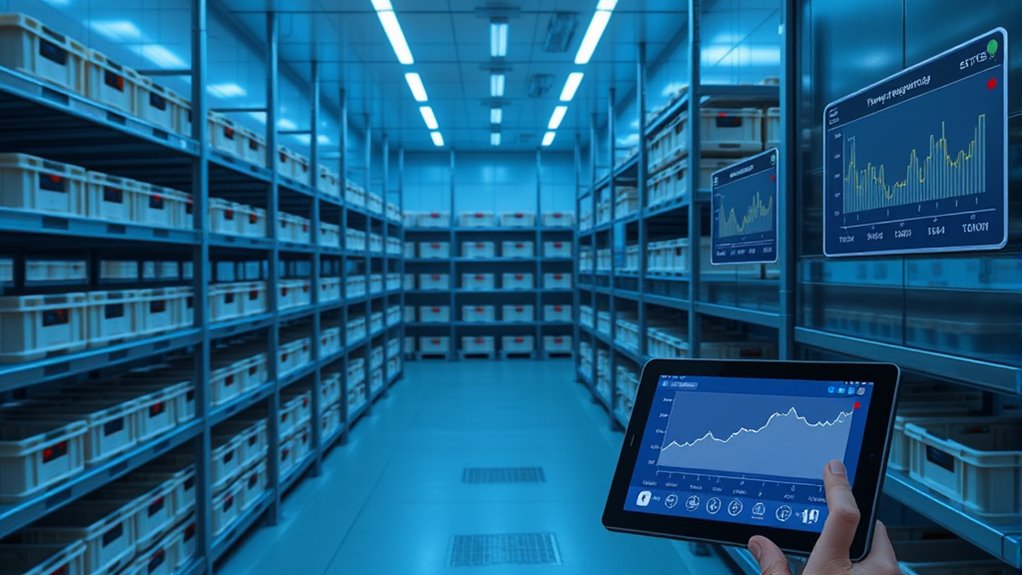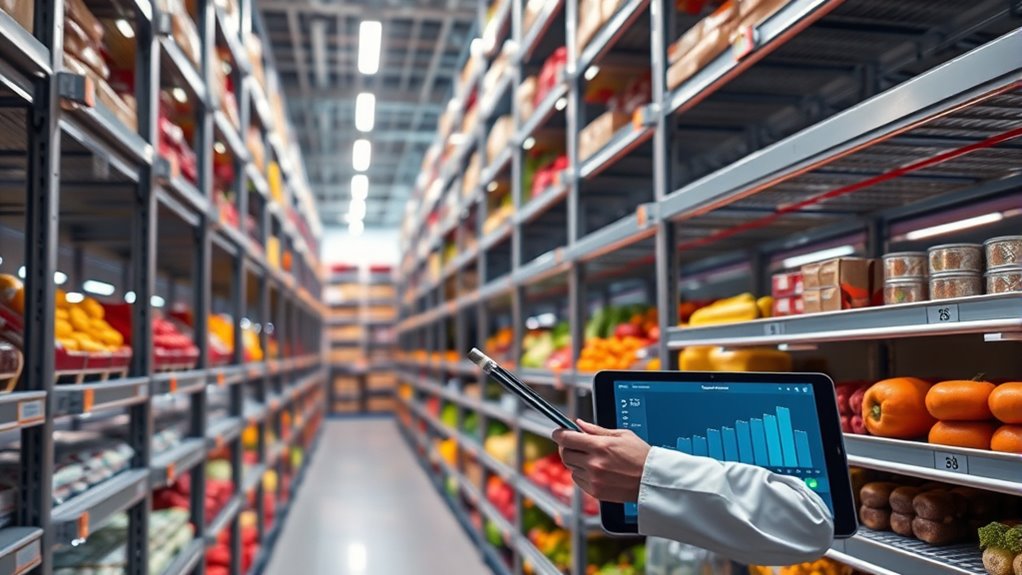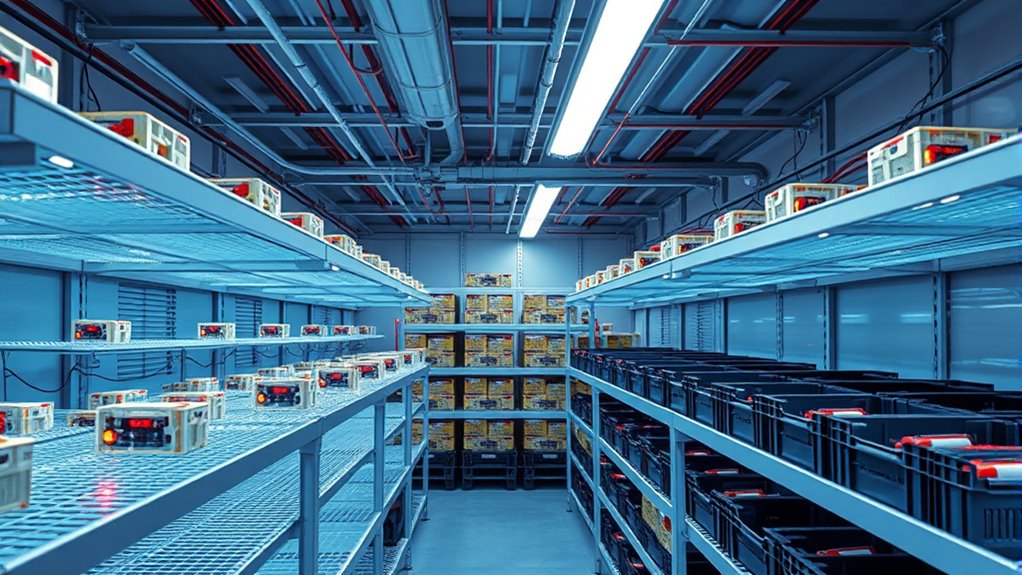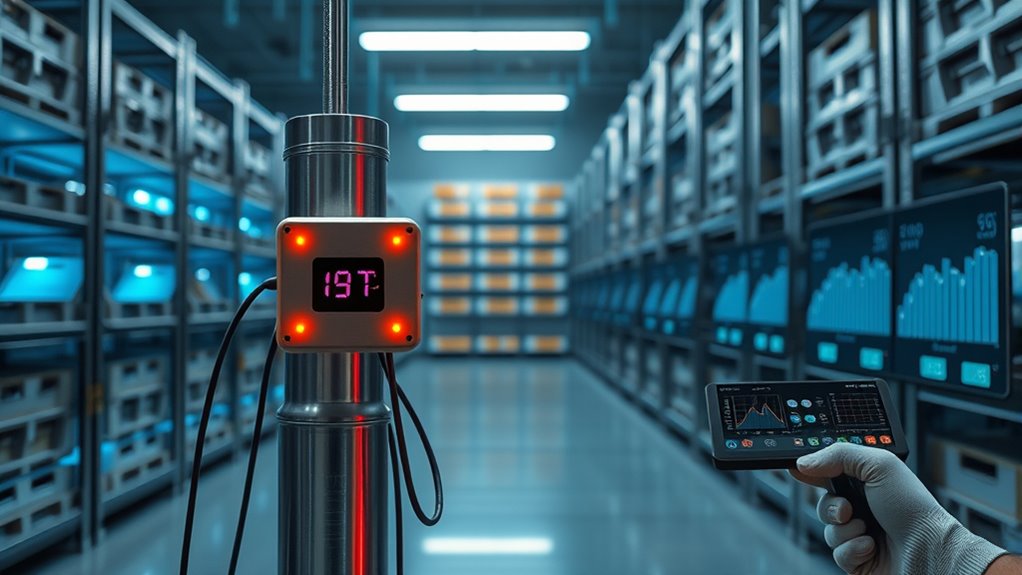Using IoT sensors in cold storage helps you monitor conditions like temperature and humidity in real-time, preventing spoilage and reducing waste. These sensors provide immediate alerts for any deviations, allowing you to respond swiftly and keep products safe. They also collect data over time to optimize operations and improve efficiency. If you want to learn how to implement these systems effectively and maximize their benefits, the details ahead will guide you through the process.
Key Takeaways
- IoT sensors provide real-time temperature and humidity data to ensure optimal cold-storage conditions.
- Automated alerts notify staff immediately of deviations, enabling quick corrective actions.
- Proper calibration and maintenance of sensors maintain measurement accuracy and system reliability.
- Integration with existing infrastructure enhances control, visibility, and operational efficiency.
- Advanced features like AI analytics and secure data transmission improve predictive maintenance and data security.
The Role of IoT Sensors in Cold Storage Environments

IoT sensors play a critical role in cold storage environments by providing real-time monitoring of temperature, humidity, and other key conditions. You rely on these sensors to continuously track environmental parameters, ensuring the stored products stay within safe ranges. When conditions fluctuate unexpectedly, sensors instantly alert you, allowing quick intervention to prevent spoilage or damage. They also gather data over time, helping you identify trends, optimize storage processes, and maintain compliance with safety standards. By integrating sensors into your system, you gain greater control and visibility, reducing the risk of costly errors. This proactive approach minimizes waste, enhances product quality, and improves overall operational efficiency. Additionally, understanding the contrast ratio can help in designing better visual monitoring systems that ensure clear visibility of temperature and humidity readings through displays or cameras. IoT sensors are essential tools for maintaining the integrity of your cold storage environment.
Key Features and Types of IoT Sensors for Temperature Monitoring

Understanding the key features and types of temperature monitoring sensors is essential for selecting the right technology for your cold storage needs. You should look for sensors with high accuracy, quick response times, and reliable data transmission. Wireless sensors are popular because they’re easy to install and eliminate wiring issues, while wired sensors can offer more stability in certain environments. Temperature sensors come in various types, such as thermocouples, RTDs, and digital sensors, each suited for different ranges and precision levels. Some sensors also include features like real-time alerts, data logging, and long battery life. Choosing the right sensor depends on your specific storage conditions, budget, and the level of monitoring detail you require. Proper selection guarantees efficient, consistent temperature control and enhances cold storage security. Additionally, understanding industry trends can help you stay ahead in adopting innovative solutions that improve monitoring efficiency and reliability.
Implementing IoT Solutions in Cold Storage Facilities

Implementing IoT solutions in cold storage facilities involves integrating sensor technology with existing infrastructure to achieve real-time temperature monitoring and control. You’ll need to assess your current setup, identify key areas for sensor placement, and guarantee compatibility with your network systems. Proper installation is essential—place sensors strategically to cover all critical zones, avoiding blind spots. Regular calibration and maintenance keep sensors accurate, while secure network connections protect data integrity. Training staff on system operation ensures smooth adoption. Consider scalability from the start, allowing for future upgrades. Additionally, coordinate with IoT providers for support and troubleshooting. Ensuring sensor reliability through proper maintenance is crucial for continuous operation.
Benefits of Real-Time Data and Automated Alerts

Real-time data and automated alerts transform cold storage management by providing immediate insights into temperature fluctuations and equipment performance. With instant updates, you can quickly identify issues like rising temperatures or malfunctioning units, preventing spoilage or loss. Automated alerts notify you the moment a problem occurs, enabling swift action without constant manual monitoring. This proactive approach minimizes downtime and helps maintain ideal conditions effortlessly. Additionally, real-time data enables better decision-making, such as adjusting cooling strategies or scheduling maintenance before minor issues escalate. By leveraging these technologies, you reduce operational risks and improve overall efficiency. Furthermore, understanding and addressing AI vulnerabilities is crucial to ensure the safety and reliability of automated systems. Ultimately, real-time insights and automated alerts empower you to keep cold storage environments secure, compliant, and reliably functioning—saving time, money, and resources.
Challenges and Considerations in IoT Cold-Storage Systems

As you implement IoT sensors in cold storage, you need to address key challenges like data security risks and ensuring sensitive information stays protected. Power management is essential to keep sensors running reliably without frequent replacements or disruptions. Additionally, maintaining sensor calibration accuracy is critical for trustworthy data, but it requires ongoing attention and fine-tuning. Incorporating vetted sensor solutions can help mitigate some of these issues by providing trusted and reliable technology.
Data Security Concerns
While IoT sensors enhance cold-storage monitoring by providing precise data, they also introduce significant security challenges. Your system becomes vulnerable if malicious actors access sensitive information or manipulate data. Data breaches can compromise inventory integrity, lead to theft, or cause spoilage. To mitigate risks, consider these security concerns:
- Unauthorized access to network devices
- Data interception during transmission
- Weak authentication protocols
- Insufficient encryption methods
- Device vulnerabilities and firmware flaws
Addressing these issues requires implementing strong encryption, regular software updates, secure authentication, and network segmentation. You must also monitor for suspicious activity continuously. Ensuring robust security measures protects your cold storage environment from cyber threats and maintains the integrity and safety of your stored products. Additionally, understanding the trustworthiness of IoT devices can help in selecting reliable sensors that adhere to security standards.
Power Management Strategies
Managing power consumption in IoT cold-storage systems presents unique challenges that directly impact operational reliability and security. To address this, you should implement energy-efficient hardware and optimize power usage through intelligent scheduling. Use low-power modes during periods of inactivity to conserve battery life, especially for remote sensors. Consider deploying renewable energy sources, like solar panels, to reduce dependency on grid power. Guarantee your system can dynamically adjust power based on real-time data, such as temperature fluctuations or equipment status. Proper power management also involves implementing fail-safes to prevent unexpected shutdowns that could compromise data integrity or system operation. Additionally, incorporating energy-efficient styling techniques can further reduce overall power consumption. By balancing power efficiency with continuous monitoring, you can enhance system longevity, reduce operational costs, and maintain the security of your cold-storage environment.
Sensor Calibration Accuracy
Ensuring accurate sensor calibration is critical for reliable temperature monitoring in IoT cold-storage systems. If sensors are miscalibrated, you risk incorrect data, leading to potential spoilage or safety issues. Proper calibration guarantees sensors provide precise readings over time. Consider these key factors:
- Regular calibration schedules to account for drift
- Using traceable standards for consistency
- Environmental influences like humidity or temperature fluctuations
- Calibration methods suitable for your sensor type
- Documentation of calibration procedures for compliance
Neglecting calibration accuracy can cause false alarms or missed temperature deviations. You must verify calibration regularly, especially after system maintenance or sensor replacements. Maintaining calibration integrity guarantees your cold storage remains within safe parameters and minimizes product loss. Additionally, understanding sensor drift is essential to anticipate and correct gradual inaccuracies over time.
Case Studies Demonstrating Successful IoT Integration

Many businesses have improved operations by integrating IoT sensors for cold storage. You’ll see how real-time temperature tracking prevents spoilage and maintains quality. Additionally, these systems enhance inventory management, reducing waste and increasing efficiency. Proper monitoring hours ensure optimal performance and compliance with safety standards.
Real-Time Temperature Tracking
When IoT sensors are integrated into cold storage facilities, real-time temperature tracking becomes highly effective, providing immediate insights that help prevent spoilage and maintain ideal conditions. You can monitor temperature fluctuations instantly, enabling quick responses to issues before spoilage occurs. Successful case studies highlight how real-time data allows for proactive adjustments, reducing waste and ensuring product quality. This technology also offers automated alerts, so you’re notified immediately if temperatures drift outside safe ranges. By continuously tracking data, you gain a detailed history to analyze patterns and optimize storage conditions. Additionally, sensor data accuracy is crucial for reliable monitoring and effective decision-making.
Improved Inventory Management
Integrating IoT sensors into cold storage facilities transforms inventory management by providing real-time visibility into stock levels and product conditions. With instant data access, you can prevent stockouts, reduce waste, and streamline replenishment processes. For example, a refrigerated warehouse used IoT to monitor inventory, which lowered spoilage rates and improved order accuracy. Here’s a snapshot of how IoT enhances inventory management:
| Benefit | Impact |
|---|---|
| Real-time stock tracking | Immediate alerts for low or excess stock |
| Condition monitoring | Ensures products stay within safe parameters |
This setup allows you to make informed decisions quickly, optimize storage space, and improve overall supply chain efficiency. IoT-driven inventory management minimizes errors and maximizes freshness, boosting customer satisfaction.
Future Trends and Innovations in Cold-Storage Monitoring

Advancements in IoT technology are driving innovative solutions that will transform cold-storage monitoring in the coming years. Expect smarter sensors with higher accuracy, enabling real-time data analysis and instant alerts for temperature deviations. AI integration will predict equipment failures before they happen, reducing downtime. Blockchain could enhance data security and traceability across supply chains. Additionally, energy-efficient devices will lower operational costs and environmental impact. You might also see the adoption of autonomous drones or robots for inspecting large storage facilities.
- Smarter sensors with predictive analytics
- AI-driven maintenance alerts
- Blockchain for secure data sharing
- Energy-efficient IoT devices
- Autonomous inspection systems
Frequently Asked Questions
How Secure Are Iot Sensors Against Cyber-Attacks in Cold Storage?
You’re probably wondering how secure IoT sensors are against cyber-attacks. While they offer great benefits like real-time monitoring, they can be vulnerable if not properly protected. Hackers might target these devices to disrupt operations or access sensitive data. To keep them safe, you should implement strong encryption, regular updates, and network security measures. Staying vigilant helps guarantee your cold storage remains secure against cyber threats.
What Is the Typical Lifespan of Iot Sensors in Cold Environments?
Did you know IoT sensors typically last 3 to 5 years in cold environments? You’ll find that their lifespan depends on factors like temperature fluctuations, humidity, and maintenance. Cold storage conditions can accelerate wear, but with proper calibration and regular checks, you can extend their usability. By understanding these factors, you guarantee your sensors remain reliable and effective for monitoring and maintaining ideal storage conditions.
How Do Iot Sensors Impact Energy Consumption in Cold Storage Facilities?
You might wonder how IoT sensors affect energy use in cold storage. They help optimize temperature control by providing real-time data, so you can adjust cooling systems more precisely. This reduces unnecessary energy consumption and prevents overcooling. By continuously monitoring conditions, you save energy and lower costs. Overall, IoT sensors make your facility more efficient, helping you cut down on energy waste while maintaining ideal storage conditions.
Can Iot Sensors Be Integrated With Existing Warehouse Management Systems?
Sure, you can integrate IoT sensors with your warehouse management system—if you’re into high-tech wizardry. Most modern systems are designed for compatibility, making it a breeze (or a headache, depending on your tech luck). You just need to guarantee your WMS supports APIs or has open architecture. With some clever setup, IoT sensors will chat effortlessly with your existing system, transforming chaos into cold, efficient order.
What Training Is Required for Staff to Operate Iot Monitoring Systems Effectively?
To operate IoT monitoring systems effectively, you need targeted training for your staff. This includes understanding sensor setup, data interpretation, and troubleshooting. You should also train them on system integration with existing warehouse management tools and cybersecurity best practices. Hands-on sessions, user manuals, and ongoing support help guarantee your team becomes confident in managing the technology, reducing errors, and maintaining ideal cold storage conditions.
Conclusion
As you explore the power of IoT sensors for cold storage, remember that the future holds even more advanced and integrated solutions. Will your facility be ready to harness these innovations? The potential for smarter, more secure storage is within reach — but only if you act now. Stay ahead of challenges and open new possibilities before your competitors do. The next breakthrough could be just around the corner; are you prepared to seize it?









